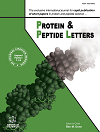- Home
- A-Z Publications
- Protein and Peptide Letters
- Issue Home
Protein and Peptide Letters - Current Issue
Volume 32, Issue 1, 2025
-
-
Exploring New Structures of Kinase Inhibitors and Multitarget Strategies in Alzheimer's Disease Treatment
More LessAuthors: Siddhant Tripathi, Yashika Sharma and Dileep KumarAlzheimer's disease (AD) treatments currently available have ineffective results. Previously employed Acetylcholine esterase inhibitors and memantine, an NMDA receptor antagonist, target a single target structure that plays a complex role in the multifactorial progression of disease. Memantine moderates the toxic effects of excessive glutamate activity by blocking NMDA receptors, which decreases neurotoxicity in A Read More
-
-
-
Targeting APE1: Advancements in the Diagnosis and Treatment of Tumors
More LessAuthors: Minghui Hu, Yingyu Zhang, Pin Zhang, Kangbo Liu, Mengxin Zhang, Lifeng Li, Zhidan Yu, Xianwei Zhang, Wancun Zhang and Ying XuWith the emergence of the precision medicine era, targeting specific proteins has emerged as a pivotal breakthrough in tumor diagnosis and treatment. Apurinic/apyrimidinic Endonuclease 1 (APE1) is a multifunctional protein that plays a crucial role in DNA repair and cellular redox regulation. This article comprehensively explores the fundamental mechanisms of APE1 as a multifunctional enzyme in biology, with par Read More
-
-
-
Recombinant Production of Ib-AMP4 and Oncorhyncin II Antimicrobial Peptides and Antimicrobial Synergistic Assessment on the Treatment of Staphylococcus aureus Under In vitro Condition
More LessAuthors: Majid Safari, Hamid Abtahi, Shima Chehreii and Shohreh FahimiradBackgroundMethicillin-resistant Staphylococcus aureus (MRSA) is a significant and prevalent pathogen that poses a major challenge in healthcare environments. In light of the growing threat posed by multidrug-resistant organisms like MRSA, there is an urgent need for alternative therapeutic strategies. One promising avenue of research involves the use of antimicrobial peptides (AMPs). These naturally occurring molecules, w Read More
-
-
-
Identifying the Role of Individual Seal IAPP Amino Acids in Inhibiting the Aggregation of Human IAPP
More LessIntroductionThe progression of type 2 diabetes in humans appears to be linked to the loss of insulin-producing β-cells. One of the major contributors to β-cell loss is the formation of toxic human IAPP amyloid (hIAPP, Islet Amyloid Polypeptide, amylin) in the pancreas. Inhibiting the formation of toxic hIAPP amyloid could slow, if not prevent altogether, the progression of type 2 diabetes. Many non-human organisms also express a Read More
-
-
-
Exploring the Regulatory Interaction of Differentially Expressed Proteins in Cleft Palate Induced by Retinoic Acid
More LessAuthors: Liyun Chen, Aiwei Ma, Lewen Jiang, Jufeng Fan, Wenshi Jiang, Mengjing Xu, Xujue Bai, Jianda Zhou, Wancong Zhang and Shijie TangObjectiveThis study aimed to identify novel proteins involved in retinoic acid (RA)-induced embryonic cleft palate development.MethodsThe palate tissues of the control and RA-treated E14.5 were dissected and subjected to iTRAQ-based proteomic analysis.ResultsDifferential expression analysis identified 196 significantly upregulated and 149 downregulated considerably proteins in RA-induced palate tissues. Comprehensive Gene Read More
-
-
-
Overexpression of HIF2α Enhances the Angiogenesis-Promoting Effect of hUC-MSC-Derived Extracellular Vesicles by Stimulating miR-146a
More LessAuthors: Yihui Chen, Shichai Hong, Zhefeng Wang, Xiang Hong, Gang Chen, Yulong Huang, Yue Lin, Xinsheng Xie, Chenwei Lin and Weifeng LuObjectiveThis study aimed to explore whether excessive HIF2α can amplify the impact of human Umbilical Cord Mesenchymal Stem Cell-derived Extracellular Vesicles (hUC-MSC-EVs) on endothelial cells.MethodsIn this study, we created HIF2α-overexpressing hUC-MSC-EVs and compared their pro-angiogenic effects with control EVs on Human Umbilical Vein Endothelial Cells (HUVECs). MTT assay and Edu staining were used to d Read More
-
-
-
Leptin/Melanocortin Pathway in Cholelithiasis Patients: A Diagnostic Perspective
More LessAuthors: Tugba Agbektas, Gulsen Guclu, Ayca Tas, Esma Ozmen, Omer Topcu, Suleyman Aydin and Yavuz SiligBackgroundCholelithiasis is the most prevalent inflammatory condition of the gallbladder. The regulation of biological processes, including energy homeostasis, and control of body weight are key mechanisms that the leptin and melanocortin pathways play a role in Cholelithiasis is the most prevalent inflammatory condition of the gallbladder. There are various risk factors for the development of gallstone disease, especially Read More
-
Volumes & issues
-
Volume 32 (2025)
-
Volume 31 (2024)
-
Volume 30 (2023)
-
Volume 29 (2022)
-
Volume 28 (2021)
-
Volume 27 (2020)
-
Volume 26 (2019)
-
Volume 25 (2018)
-
Volume 24 (2017)
-
Volume 23 (2016)
-
Volume 22 (2015)
-
Volume 21 (2014)
-
Volume 20 (2013)
-
Volume 19 (2012)
-
Volume 18 (2011)
-
Volume 17 (2010)
-
Volume 16 (2009)
-
Volume 15 (2008)
-
Volume 14 (2007)
-
Volume 13 (2006)
-
Volume 12 (2005)
-
Volume 11 (2004)
-
Volume 10 (2003)
-
Volume 9 (2002)
-
Volume 8 (2001)
Most Read This Month Most Read RSS feed
Article
content/journals/ppl
Journal
10
5
false
en


